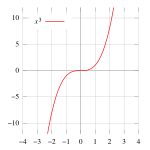A point where the curvature vanishes but does not change sign is sometimes called a point of undulation or undulation point.
In algebraic geometry an inflection point is defined slightly more generally, as a point where the tangent meets the curve to order at least 3, and an undulation point or hyperflex is defined as a point where the tangent meets the curve to order at least 4.
Equivalent forms
The following are all equivalent to the above definition:- a point on a curve at which the second derivative changes sign. This is very similar to the previous definition, since the sign of the curvature is always the same as the sign of the second derivative, but note that the curvature is not the same as the second derivative.
- a point (x, y) on a function, f(x), at which the first derivative, f′(x), is at an extremum, i.e. a (local) minimum or maximum. (This is not the same as saying that y is at an extremum).
- a point p on a curve at which the tangent crosses the curve at that point. For an algebraic curve, this means a non singular point where the multiplicity of the intersection at p of the tangent line and the curve is odd and greater than 2.[2]
A necessary but not sufficient condition
If x is an inflection point for f then the second derivative, f″(x), is equal to zero if it exists, but this condition does not provide a sufficient definition of a point of inflection. One also needs the lowest-order (above the second) non-zero derivative to be of odd order (third, fifth, etc.). If the lowest-order non-zero derivative is of even order, the point is not a point of inflection, but an undulation point. However, in algebraic geometry, both inflection points and undulation points are usually called inflection points. An example of such an undulation point is y = x4 for x=0.It follows from the definition that the sign of f′(x) on either side of the point (x,y) must be the same. If this is positive, the point is a rising point of inflection; if it is negative, the point is a falling point of inflection.
Categorization of points of inflection
Points of inflection can also be categorized according to whether f′(x) is zero or not zero.- if f′(x) is zero, the point is a stationary point of inflection, also known as a saddle-point
- if f′(x) is not zero, the point is a non-stationary point of inflection
A non-stationary point of inflection can be visualised if the graph y = x3 is rotated slightly about the origin. The tangent at the origin still cuts the graph in two, but its gradient is non-zero.
Note that an inflection point is also called an ogee, although this term is sometimes applied to the entire curve which contains an inflection point.[citation needed]



